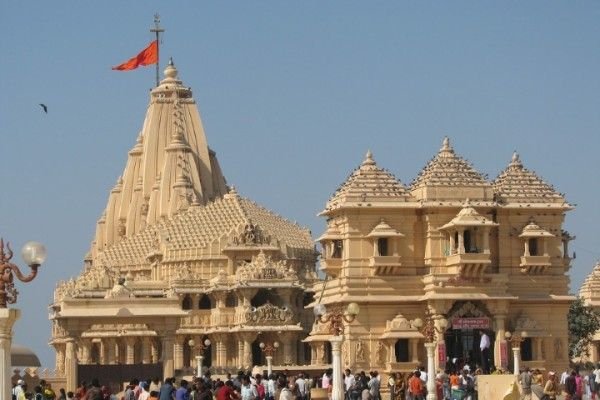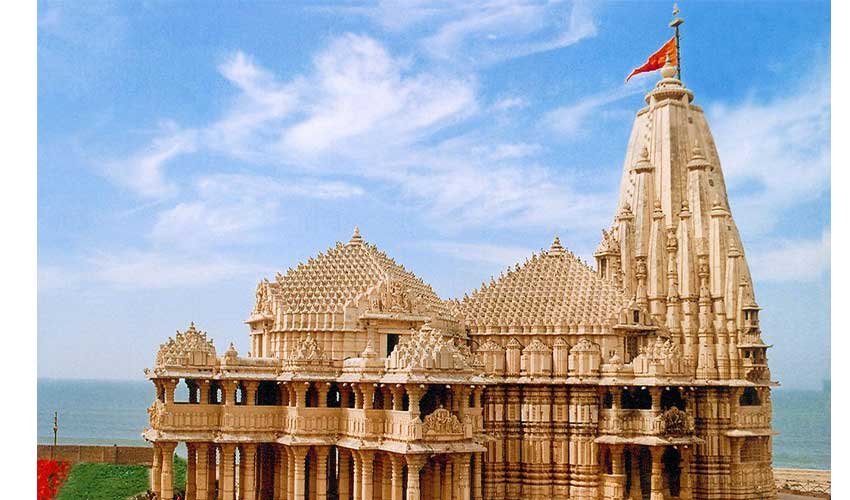The Somnath Temple in Gujarat is one of the most sacred and celebrated shrines dedicated to Lord Shiva. Known as the first Jyotirlinga among the twelve Jyotirlingas of India, it holds immense spiritual, cultural, and historical importance. Every year, millions of devotees visit Somnath to experience its divine energy, learn about its legendary past, and admire its breathtaking seaside architecture.
Located in Prabhas Patan near Veraval, the temple stands proudly on the western coast of India, overlooking the vast Arabian Sea. The rhythmic sound of waves, the temple’s golden glow at sunset, and its peaceful surroundings make it a must-visit destination for pilgrims and tourists alike.
Whether you’re coming for darshan, exploring Somnath Holy Temple history, or searching for hotels near Somnath Temple, this complete guide will help you plan your visit comfortably.
History of Somnath Temple

The history of Somnath Mahadev Temple is an extraordinary story of faith, destruction, rebuilding, and devotion. According to ancient scriptures, the temple was first constructed by Chandra Dev (the Moon God). He worshipped Lord Shiva to free himself from a curse, and upon receiving Shiva’s blessings, the temple came to be known as Somanath—“The Lord of Soma”.
Over thousands of years, Somnath evolved into a powerful spiritual center. It is mentioned in the Rigveda, Shiv Purana, and Skanda Purana, proving its deep roots in ancient Indian civilization.
Somnath was not only a place of devotion but also a center of learning and culture. Its enormous wealth made it one of the richest temples in India, which unfortunately attracted many invaders throughout history.
Who Built Somnath Temple?
According to legends and religious texts, the Somnath Holy Temple was built and rebuilt several times:
- Chandra Dev first built it in gold.
- Ravana, the king of Lanka, rebuilt it in silver.
- Lord Krishna later rebuilt it in sandalwood.
- Solanki King Bhimdev constructed it in stone during the medieval period.
The magnificent temple we see today was rebuilt in 1951, initiated by Sardar Vallabhbhai Patel, who believed Somnath should be restored as a symbol of cultural pride. After Patel’s passing, Dr. Rajendra Prasad, the first President of India, completed the inauguration ceremony.
Somnath Temple Destroyed By Whom?
A Neutral, Respectful Historical Overview
Throughout history, the Somnath Mahadev Temple was attacked multiple times because of its immense wealth and popularity. Historical records suggest the temple was destroyed and rebuilt around 17 times.
Some major invasions include:
- Mahmud of Ghazni (1025 CE) – the most documented attack.
- Later invasions by Afghan and Mughal rulers, including generals of Alauddin Khilji, who targeted the shrine to seize its wealth.
Despite these repeated destructions, the temple was rebuilt every time by local kings, merchants, saints, and devotees. The present-day temple stands as a symbol of India’s unshakeable faith and cultural resilience.
Architecture of Somnath Temple
The Somnath Holy Temple is an excellent example of Chalukya architectural style, showcasing ancient Indian craftsmanship and engineering brilliance.
1. The Grand Shikhara
The main spire rises 155 feet high, intricately carved with designs inspired by Hindu symbols and mythology.
2. Sabhamandap and Garbha Griha
The inner sanctum (Garbha Griha) houses the revered Jyotirlinga, believed to be self-manifested (Swayambhu).
3. Stunning Sea-Facing Location
An ancient inscription near the temple states that between Somnath and the South Pole, there is no landmass. This makes the temple uniquely positioned on the Indian coastline.
4. Evening Aarti & Sound–Light Show
- The Sandhya Aarti is a spiritually uplifting experience with chants, bells, incense, and rhythmic music.
- The Sound and Light Show, held every evening, narrates the temple’s long and inspiring history.
How to Reach Somnath Temple
Somnath is easily accessible from major cities in Gujarat and India by air, train, and road.
1. By Flight – How to Reach Somnath Temple by Flight
Somnath Temple Airport
Somnath does not have its own airport. The nearest airports are:
- Diu Airport (DIU) – ~65 km (most preferred)
- Porbandar Airport – ~120 km
- Rajkot Airport (RAJ) – ~160 km
- Ahmedabad Airport – ~400 km (major international flights)
Visitors usually choose Diu Airport because it’s closest and well-connected by road.
Travel from Airport to Somnath
- Taxi: Easily available from Diu, Porbandar, or Rajkot.
- Bus: Regular buses run from Diu to Veraval and Somnath.
2. By Train – Nearest Station to Somnath Temple
There are two main railway stations near Somnath:
- Somnath Railway Station (SMNH) – around 1 km from the temple
- Veraval Junction (VRL) – 5–6 km away and better connected
Trains connect these stations to major cities like:
- Ahmedabad
- Vadodara
- Surat
- Mumbai
- Rajkot
- Delhi
- Pune
Train travel is economical and convenient for pilgrims.
3. By Road
Somnath is connected by well-maintained highways. Major routes include:
- Ahmedabad → Somnath: approx. 400 km
- Rajkot → Somnath: approx. 190 km
- Junagadh → Somnath: approx. 80 km
Visitors can travel by:
- Overnight luxury buses
- Private taxis
- Self-drive cars
The coastal drive along Gujarat’s shoreline is scenic and enjoyable.
Hotels Near Somnath Temple
Finding hotels near Somnath Mahadev Temple is easy because the area has a wide range of accommodation options for all budgets.
1. Budget Hotels
- Affordable and clean rooms
- Located within walking distance from the temple
- Ideal for short stays
2. Mid-Range Hotels
- AC rooms
- In-house dining facilities
- Suitable for families and group travelers
3. Premium Hotels
- Sea-view rooms
- Multi-cuisine restaurants
- Travel assistance available
4. Dharamshala Near Somnath Temple
Many devotees prefer staying in dharamshalas near Somnath Mahadev Temple, as they offer:
- Simple and clean rooms
- Low-cost stay options
- Spiritual and peaceful environment
Most dharamshalas are located within 1–3 km of the temple and are operated by trusts or community groups.
Somnath Temple to Nageshwar Temple Distance
Many pilgrims also visit the Nageshwar Jyotirlinga in Dwarka during their Gujarat trip. The distance between the two temples is:
- 235–245 km by road
- Travel time: 4.5 to 5.5 hours
The route via Porbandar coastal highway is scenic and popular among travelers.
Travel Tips for Visiting Somnath Temple
1. Best Time to Visit
- October to March – pleasant weather
- Avoid peak summer due to high temperatures
2. Darshan Timings
- Darshan available from early morning until night
- The evening Aarti is a must-attend
3. Dress Code
Wear modest, traditional clothing out of respect for the temple’s sanctity.
4. Photography
Photography is not allowed inside the temple but is permitted outside.
5. Footwear
Dedicated footwear stands are available near the entrance.
6. Assistance for Senior Citizens
Wheelchairs and support staff are available for elderly and differently-abled devotees.
Frequently Asked Questions
1. Where is the Somnath Temple located?
It is located in Prabhas Patan, near Veraval in Gujarat.
2. Who built Somnath Temple originally?
According to mythology, it was first built by Chandra Dev, and later rebuilt by Ravana, Lord Krishna, and King Bhimdev.
3. How many times was Somnath Temple destroyed?
Historical accounts say it was destroyed around 17 times.
4. What is the nearest airport to Somnath Temple?
Diu Airport (65 km) is the closest airport.
5. What is the nearest railway station to Somnath Temple?
- Somnath Railway Station (SMNH)
- Veraval Junction (VRL) – better connectivity
6. Are there dharamshalas near Somnath Temple?
Yes, several trust-run dharamshalas offer affordable accommodation.
7. Can I visit Nageshwar Temple from Somnath in one day?
Yes, it is possible with proper planning since the distance is around 235–245 km.
Conclusion
The Somnath Temple is more than a pilgrimage destination—it is a symbol of India’s timeless spirituality and resilience. From its legendary origins to its modern reconstruction, every part of Somnath reflects the devotion and cultural strength of generations. Whether you’re exploring Somnath Mahadev Temple history, looking for hotels in Somnath near the temple, planning your travel, or adding nearby Jyotirlingas like Nageshwar to your itinerary, this guide ensures a smooth and meaningful pilgrimage.
Krishna Mishra writes for Insights of Hinduism, where he shares heartfelt thoughts on festivals, traditions, and the timeless wisdom of Sanatan Dharma. His aim is to keep the essence of Hindu culture alive in a way that feels simple, authentic, and relatable to everyone.


